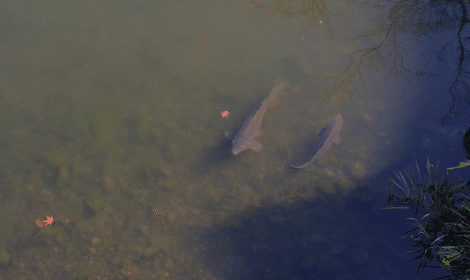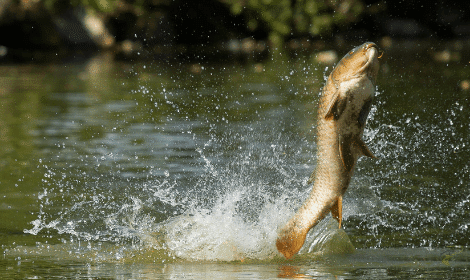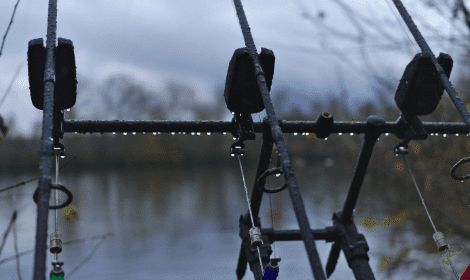
Knowing and experiencing how to stalk carp can be a lot of fun!
Fishing, no doubt, is an exhilarating and fun activity. However, many of you may find the investment of long hours that it requires a bit stressful or boring.
Who wouldn’t want to catch the largest number of fish in the shortest period? For this, the best way out is to start stalking carp.
Many anglers have been carp fishing for years but haven’t ever experienced the exciting method of stalking. The reasons for reluctance may vary. Some may find it difficult due to a large number of pegs being taken up. Others may feel that stalking carp will be a complicated and expensive option.
But in reality, stalking carp is a simple, time-saving, budget-friendly, and exciting experience. All you have to do is learn the precautions to be taken and the smart methods to be followed. Once you get the hang of it, you’ll find it hard to come back to the stationary and waiting game of some carp fishing.
This article will be a fantastic guide for those who are new to this method. And yes, not to mention, it’s also going to provide carp stalking experts with some cool tricks and tips.
What Exactly Is Stalking?
In easy words, stalking carp means sight fishing for carp on the surface or in shallow water where you can see them. But the thing that differentiates it from ordinary fishing is the drastic decrease in the time it requires. Well, that’s what you hope for anyway.
Here’s how:
When you’re stalking carp, you should be able to get really close to the fish, as long as you’re quiet and don’t spook them. If the water is clear, you can clearly see the carp. This helps you to lower your rig at the right time and in the right place. You don’t have to sit and wait for hours. Plus, you can catch the exact size and species that you’re looking for by spotting them before you cast at them.
The most exciting part about this method is that you can monitor the activity of the fish. This means that you can see which colours/sizes of baits attract them and which spook them off.
Now you’re probably wondering about how to stalk carp when you’re fishing in murky waters. I’ve got the answer. In muddy lakes, carps use their sense of smell. Therefore, using more potent baits such as hemp will help you attract as many carp as possible.
Where to Find Carp to Stalk?
The most efficient way to stalk carp is to target the best locations, i.e. where carp are found abundantly.
The question here is: what are the natural habitats of carp? Usually, carp can be found from brackish waters to coastal lakes. But more generally, larger, warmer, and slower-moving water bodies with soft muddy bottoms are preferred by them. They can be found in reservoirs, pools in streams, and lakes.
However, some species are highly tolerant and hardy. They can survive in a wide variety of aquatic habitats.
Most carp species can also stay in the water with harsh conditions, for example, in water with deficient oxygen levels or water with large temperature variations. Carp can even survive in temporary freezing waters.
In addition, the margins are commonly where you can find a large number of carp, weather depending. Lily pads and snags are also some of their favourite spots to dwell. This is because such sites have abundant aquatic vegetation. Snags, specifically, provide carp with an easy way to escape.
However, if you’re positioned close to your rod, you can land an excellent chance to pull the carp away before they swim away.
What Are the Visible Signs of Carp?

Having considered their natural habitats, let’s consider some of the most apparent signs which signal you about carp presence:
- Carp rolling
- Crashing
- Fizzing
- Swirls of movement on the surface
- Bubbles are moving along the water
How to Stalk Carp While Avoiding the Worst Locations?
Typically, the places where most anglers are fishing are considered to be the best spots. But in some cases, they turn out to be the worst. This is the case with stalking carp.
Carp will prefer to feed in areas where they feel they are safe. The fishing hot spots are absolutely not one of those places.
So, when stalking carp, make sure to try touching the untouched areas, i.e., where no one else is fishing.
Moreover, rush beds, for example, are areas that provide lesser protection to carp. Even though you may find such regions more accessible, there’s a low chance to see a dense carp population there.
On the other hand, the presence of overhanging trees indicates a good carp population. This is because they feel more protected here as they can group together. Additionally, overhanging trees may grow berries. If these fall in the water, carp may also find a source of feed.
These areas may have the best chance of holding fish but when stalking you will be looking for carp in the top sections of the water column.
So simply, any areas where you can see surface feeding or cruising on the surface is the best place for stalking.
Best time to Stalk Carp
How will you be able to stalk carp if there are a lot of disturbances? Don’t you think this will scare them off? Of course, it will.
Therefore, the best time for stalking carp is either early in the morning or when it starts to get dark or even on very quiet venues. During these hours, the margins are usually peaceful and quiet. It is often during the night hours, when anglers are all tucked up in bed, that they return to the margins to find food items in safety.
Best Weather for Stalking Carp
Changes in weather conditions have a significant impact on the presence of carp. To get the best outcome from your day at stalking, you should consider the weather for sure.
Temperature
The warmer months are most suitable to stalk carp. Warm water encourages the carp to spend most of their time near the surface and in shallower water.
This means that you won’t have to throw in loads of bait. Plus, the bait and wait game could be over if you’re any good at stalking.
So, a floating bait such as bread or dog biscuits on the the surface can see success.
Atmospheric Pressure
Another weather factor that you need to consider is the barometric pressure.
High-pressure days are most suitable for stalking carp. Suppose the pressure is 29.8 inches of mercury pressure or over 1000 millibars. In that case, you are likely to catch an ample quantity of fish.
Plus, on a high-pressure day, the weather will be fair and calm, which will add up to making your experience even better.
Rain

When rain falls in the rivers and lakes, it causes air molecules to mix with the water. This increases the oxygen levels of water. As a result, the carp will be more active.
Also, rain causes water levels to rise. This dislodges organic matter. It also brings insects and worms into the water, which are food for carp. Thus, the run-off can result in areas of feeding carp.
Wind
Have you ever thought of how to stalk carp in accordance with the strength and direction of the wind?
A South-Westerly wind is ideal for stalking carp. This is because the wind in this direction tends to bring in warm air. On the other hand, a North or Easterly wind will bring in cold air.
Considering the wind’s strength, the stronger the wind, the more suited it could be for stalking carp on windward banks. This is because more food items will be pushed in the direction of the wind. As a result, carp will feed more at these banks as the wind pushed bait to them. On the other hand, potential undertow current will take the food particles in the opposite direction so this might not always be the case.
The Approach – Exactly How to Stalk Carp?
The simplified method of stalking carp is first to find the best area for stalking. Once selected, carry the correct gear to your location and start off. Carefully and slowly, throw a few handfuls of chopped boilies.
The amount thrown should be just enough to attract carp, not to stuff them. When you are sure that they are confidently feeding, cast your rig in the water.
The process of stalking carp is really fascinating as long as you know the equipment to choose and the methods to follow.
Bait
Using the right bait to stalk carp is really important. There are two types of baits that you may choose from:
- Bottom Baits: Use a 14 mm pellet surrounded by crushed up boilies or sweetcorn. These baits are the go to when you can see carp feeding on the bottom in shallow water.
- Surface Baits: This method is cheaper and can be used when you can see carp feeding on the surface. All you will need is bread from the supermarket. For every session, you will only need half a loaf. Squeeze this plain bread around a hook with the tip showing. That’s it, you can start stalking carp now!
The downside of using bread is that it isn’t very robust. This means that it will melt off quickly. A good alternative may be dog biscuits, which are much more rigid but still float.
Here are some other great bait suggestions for catching carp when stalking:
- Tiger nuts
- Luncheon meat
- Chum mixers for surface fishing
- Small, bright pineapple pop-ups
Rod
While stalking carp, you have to move around a lot. You can use any old rod, but this will be a burden when you have to hold it for prolonged hours and carry it to different places. For this reason, you can choose to buy a lightweight rod. Carrying it and moving around with it will be a lot easier.
Carp stalking rods will be shorter (around 6ft to 10ft) because you don’t need them for long distances. Plus, they will have a powerful through action to catch big fish.
Polarized Glasses
Polarized lenses offer excellent protection when fishing. They will cut glare, which reduces eye strain and prevents eye squinting.
If you can manage to get on a tree, the benefit will be doubled. You will be able to see clearly beneath the water surface. This will help you to spot your next catch a lot more clearly. Besides, you can also monitor carp’s activity, i.e., their reactions to different material and colors.
How to Stalk Carp with Precautionary Measures
Carp are spooked off very quickly. Therefore, you need to make sure not to let them notice your presence. Either it’s throwing your rig in water or adding baits to the water, you need to be as quiet as possible.This is the whole point of stalking.
Big carp, in specific, can become cautious more easily. So, if you want to catch a good number of fish, you should try not to get too close to the water. Even a giant shadow looming over carp may scare them.
In addition, you should monitor your carp’s activity. There’s a chance that it might be reluctant to come close to bright coloured baits. Lastly, when inserting your rig in the water, don’t rush. Spooking off even a single fish may result in all the fish swimming away.
And yes, don’t forget, the secret for how to stalk carp most efficiently is to have patience. When you reach your desired fishing spot, take your time and observe the area. Sometimes a great catch can be very near, but you may miss it due to hastiness and lack of observation.
Tips & Tricks on How to Stalk Carp
You may already be an expert on stalking carp. Yet, there are still common mistakes made by a lot of anglers. Such errors prevent them from stalking a decent number of carp.
Here are a few strategies which will enhance your skills:
Disguise
Whether it’s clothing yourself or moving around, remember to stay disguised. You can wear clothing that matches your surroundings. If not, then choose dull, drab clothing.
When moving around, you should be careful not to pull back the branches to reveal the swim too quickly.
When Entering A Dense Area, Break Down Your Landing Net
Breaking your landing net beforehand will increase the likeliness of catching fish. As long as fish is in the water, it can break away from the hook. Having your net ready to go could be the difference between a fish in the net or a lost fish.
Here are some other suggestions which will make your stalking experience perfect:
- Top up the regularly baited areas
- Carry a variety of baits
- Walk around the lake several times, so you don’t miss out on anything.
That’s All!
Along with being an incredible experience, the procedure of how to stalk carp is a very critical one. Once you’ve understood the technicalities of stalking carp, you’re gonna love it!
Summer is almost here, so go grab your rods and get out there for stalking carp.

